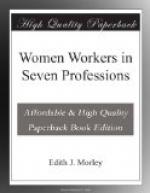Now let us turn to a consideration of the poor mother. Dr Matthews Duncan in 1870 put the puerperal mortality at 1 in 100 for in-patients and 1 in 120 for patients in their own homes—shocking figures for a physiological event! Miss Wilson, a member of the Central Midwives Board, stated in 1907 that the average mortality of English women, from puerperal fever, a preventable disease, is 47 in 10,000 or 1 in 213, but that in three of the best lying-in hospitals this figure has been reduced to less than 1 in 3,000. To quote Miss Alice Gregory in her article on this subject in The Nineteenth Century for January 1908: “We feel there is something hopelessly wrong somewhere. It becomes indeed a burning question: By what means have the Maternity Hospitals so marvellously reduced their death rate?”
The answer is not now far to seek in the opinion of the writer, who has worked continuously at Midwifery since 1st May 1884. It is probably wholly contained in the three following points:—
(1) All that makes for scrupulous asepsis
in
every detail for the surroundings of the
mother.
(2) The absence of “Meddlesome Midwifery.”
(3) Pre-maternity treatment, a factor which the writer considers to be of great importance, and of which she would like to have much more experience.
By this is meant the building up of the future mother’s health by improved hygiene and careful, wise dieting and exercising and bathing during the last three months of pregnancy, which enables many a stumbling-block to be removed out of the way. Hence, the utility of pre-maternity wards wisely used. This is, one knows, a “counsel of perfection”; but every expectant mother should and could be taught how to treat herself wisely at this time.
These three points are all in favour of the well-trained midwife.
(1) Scrupulous Asepsis, if intelligently taught, can be learned in six months’ training, though one feels bound to add it requires moral “grit” in the character to make one unswervingly faithful in observing it. The midwife, too, should run no risk of carrying infection from others, as a doctor might do.
(2) “Meddlesome Midwifery” is not so much a temptation for the midwife as the doctor, though she also may want to do too much. Patience combined with accurate knowledge when interference is urgently needed, is part of her training.
(3) The midwife who becomes a wise friend to her patients will be just the one to whom the mother will gladly apply early, and who will know if it is advisable to send for skilled medical advice. Contracted pelvis, threatened eclampsia, and antepartum haemorrhage are typical cases, which lose half their terror if diagnosed and treated early.
If ever it is recognised that good midwifery is at the root of the health of the nation and the new maternity benefit is made to help in obtaining it, it will at once become worth while for educated and intelligent women to take to the profession seriously. A practice could then be worked by sets of two or three midwives in co-operation, and with proper organisation as regards an insurance fund for securing operative midwifery from medical practitioners when necessary.




